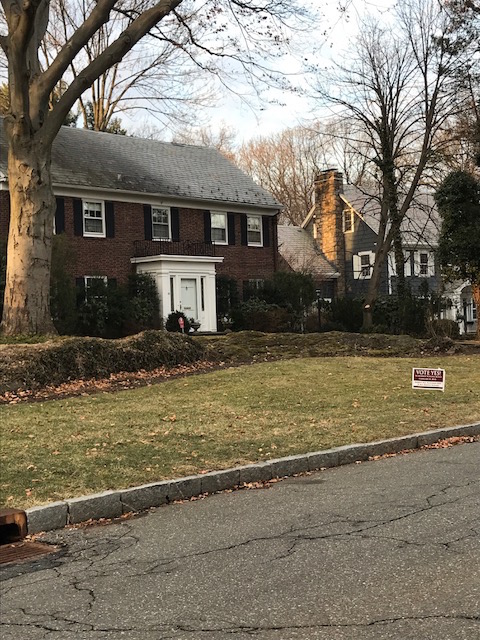Appeals Court Rules in Favor of Scarsdale Village in Case Regarding Placement of Signs in the Right of Way
- Tuesday, 07 December 2021 15:34
- Last Updated: Wednesday, 22 June 2022 08:09
- Published: Tuesday, 07 December 2021 15:34
- Joanne Wallenstein
- Hits: 3033
 The saga over the placement of political signs in the Village right of way continues this week with a new ruling on an appeal to the U.S. Court of Appeals for the Second Circuit. Now more than three and a half years after police removed signs supporting a controversial bond referendum from the Village right of way, which is the first 13 feet from the curb, on December 3, 2021 the Court of Appeals issued their judgment in the appeal of Robert Berg vs. the Village of Scarsdale and the Village of Scarsdale Police Department.
The saga over the placement of political signs in the Village right of way continues this week with a new ruling on an appeal to the U.S. Court of Appeals for the Second Circuit. Now more than three and a half years after police removed signs supporting a controversial bond referendum from the Village right of way, which is the first 13 feet from the curb, on December 3, 2021 the Court of Appeals issued their judgment in the appeal of Robert Berg vs. the Village of Scarsdale and the Village of Scarsdale Police Department.
In November 2020, the US District Court for the Southern District came out with a mixed decision on Berg’s case, finding that the Scarsdale Police Department violated the First Amendment by selectively enforcing signposting laws but denied the remainder of Berg’s motion that the Village’s signposting laws violated the Fourteenth Amendment’s Due Process Clause and the First Amendment. The 14th amendment states “no state shall deprive any person of life, liberty or property without due process of law.”
Berg appealed this decision to the U.S. Court of Appeals for the Second Circuit who evaluated Berg’s claim that the Village’s signposting violated the Fourteenth Amendment’s Due Process Clause and the First Amendment.
The relevant code “bans any person from “post[ing], attach[ing] or display[ing] any sign, notice, placard, poster, or other advertising medium to or upon or over any sidewalk, tree, stone, fence, wall, pole, railing or other object in, along, upon, or over any street, park or other public place in the village.” Special App’x at 35. Section 281-2 defines “right-of- way” as “[g]enerally, the space owned by the Village extending approximately 13 feet from each curbline.”
The court determined that the code was not vague in that a person of ordinary intelligence could be able to understand it.
Berg also argued that Village Code Section 256-1 is unconstitutional because it lacks sufficient enforcement standards. However, the court found that the Village code does not authorize or encourage arbitrary or discriminatory enforcement.
Additionally the court denied the claim that the Village code violated Berg’s right of free speech, finding “The Village Code is a content-neutral regulation because it prohibits “any” and “all” signposting on public property. “Content-neutral regulations may limit the time, place, or manner of expression—whether oral, written, or symbolized by conduct—even in a public forum, so long as the restrictions are reasonable, are narrowly tailored to serve a significant governmental interest, and leave open ample alternative channels for communication of the information.”
The district court found that the provisions are “narrowly tailored” to advance the substantial government interests identified above.
Lastly, the court found that the Village’s regulations leave ample opportunity for protected speech because signs can be posted on private property. In this case, signs posted on the Village right-of-way could simply be moved further back from the curb line until they were on private land. Therefore, the Village’s sign ordinances are permissible content-neutral time, place, and manner restrictions and do not violate the First Amendment.
Finally, Berg argued that the provision was selectively enforced as it barred the placement of political signs at the same time it was permitting commercial lawn signs. The court determined a plaintiff must show a “pattern of unlawful favoritism.” Thomas v. Chi. Park Dist., 534 U.S. 316, 325 (2002). Berg’s claim that the Village unlawfully favored commercial signs, while enforcing the Code against political signs, cannot survive summary judgment.
The ruling says, “Although Berg has submitted photographs of commercial signs that were not removed from the public right-of-way in that later timeframe, there is no evidence that there were complaints about the location of those signs that were brought to the attention of the police, and that any such complaints were ignored. In short, based upon the uncontroverted evidence, no rational juror could find that the Village was engaged in a “pattern of unlawful favoritism” towards commercial signs based upon its enforcement of the Village Code. Thomas, 534 U.S. at 325.1.
Therefore the court found Berg’s arguments to be without merit , reversed the district court judgment and found in favor of the Village.







